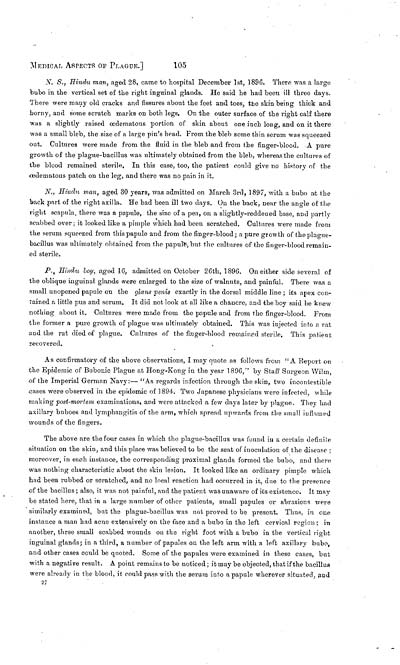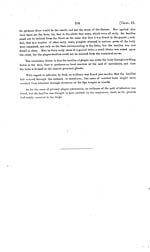Medicine - Disease > Bombay plague: being a history of the progress of plague in the Bombay presidency from September 1896 to June 1899
(141) Page 105
Download files
Individual page:
Thumbnail gallery: Grid view | List view

MEDICAL ASPECTS OF PLAGUE.] 105
N. S., Hindu man, aged 28, came to hospital December 1st, 1896. There was a large
bubo in the vertical set of the right inguinal glands. He said he had been ill three days.
There were many old cracks and fissures about the feet and toes, the skin being thick and
horny, and some scratch marks on both legs. On the outer surface of the right calf there
was a slightly raised dematons portion of skin about one inch long, and on it there
was a small bleb, the size of a large pin's head. From the bleb some thin serum was squeezed
out. Cultures were made from the fluid in the bleb and from the finger-blood. A pure
growth of the plague-bacillus was ultimately obtained from the bleb, whereas the cultures of
the blood remained sterile. In this case, too, the patient could give no history of the
dematous patch on the leg, and there was no pain in it.
N., Hindu man, aged 30 years, was admitted on March 3rd, 1897, with a bubo at the
back part of the right axilla. He had been ill two days. On the back, near the angle of the
right scapula, there was a papule, the size of a pea, on a slightly-reddened base, and partly
scabbed over; it looked like a pimple which had been scratched. Cultures were made from
the serum squeezed from this papule and from the finger-blood; a pure growth of the plague-
bacillus was ultimately obtained from the papule, but the cultures of the finger-blood remain-
ed sterile.
P., Hindu boy, aged 16, admitted on October 26th, 1896. On either side several of
the oblique inguinal glands were enlarged to the size of walnuts, and painful. There was a
small unopened papule on the glans penis exactly in the dorsal middle line; its apex con-
tained a little pus and serum. It did not look at all like a chancre, and the boy said he knew
nothing about it. Cultures were made from the papule and from the finger-blood. From
the former a pure growth of plague was ultimately obtained. This was injected into a rat
and the rat died of plague. Cultures of the finger-blood remained sterile. This patient
recovered.
As confirmatory of the above observations, I may quote as follows from "A Report on
the Epidemic of Bubonic Plague at Hong-Kong in the year 1896," by Staff Surgeon Wilm,
of the Imperial German Navy:- "As regards infection through the skin, two incontestible
cases were observed in the epidemic of 1894. Two Japanese physicians were infected, while
making post-mortem examinations, and were attacked a few days later by plague. They had
axillary buboes and lymphangitis of the arm, which spread upwards from the small inflamed
wounds of the fingers.
The above are the four cases in which the plague-bacillus was found in a certain definite
situation on the skin, and this place was believed to be the seat of inoculation of the disease;
moreover, in each instance, the corresponding proximal glands formed the bubo, and there
was nothing characteristic about the skin lesion. It looked like an ordinary pimple which
had been rubbed or scratched, and no local reaction had occurred in it, due to the presence
of the bacillus; also, it was not painful, and the patient was unaware of its existence. It may
be stated here, that in a large number of other patients, small papules or abrasions were
similarly examined, but the plague-bacillus was not proved to be present. Thus, in one
instance a man had acne extensively on the face and a bubo in the left cervical region; in
another, three small scabbed wounds on the right foot with a bubo in the vertical right
inguinal glands; in a third, a number of papules on the left arm with a left axillary bubo,
and other cases could be quoted. Some of the papules were examined in these cases, but
with a negative result. A point remains to be noticed; it may be objected, that if the bacillus
were already in the blood, it could pass with the serum into a papule wherever situated, and
27
N. S., Hindu man, aged 28, came to hospital December 1st, 1896. There was a large
bubo in the vertical set of the right inguinal glands. He said he had been ill three days.
There were many old cracks and fissures about the feet and toes, the skin being thick and
horny, and some scratch marks on both legs. On the outer surface of the right calf there
was a slightly raised dematons portion of skin about one inch long, and on it there
was a small bleb, the size of a large pin's head. From the bleb some thin serum was squeezed
out. Cultures were made from the fluid in the bleb and from the finger-blood. A pure
growth of the plague-bacillus was ultimately obtained from the bleb, whereas the cultures of
the blood remained sterile. In this case, too, the patient could give no history of the
dematous patch on the leg, and there was no pain in it.
N., Hindu man, aged 30 years, was admitted on March 3rd, 1897, with a bubo at the
back part of the right axilla. He had been ill two days. On the back, near the angle of the
right scapula, there was a papule, the size of a pea, on a slightly-reddened base, and partly
scabbed over; it looked like a pimple which had been scratched. Cultures were made from
the serum squeezed from this papule and from the finger-blood; a pure growth of the plague-
bacillus was ultimately obtained from the papule, but the cultures of the finger-blood remain-
ed sterile.
P., Hindu boy, aged 16, admitted on October 26th, 1896. On either side several of
the oblique inguinal glands were enlarged to the size of walnuts, and painful. There was a
small unopened papule on the glans penis exactly in the dorsal middle line; its apex con-
tained a little pus and serum. It did not look at all like a chancre, and the boy said he knew
nothing about it. Cultures were made from the papule and from the finger-blood. From
the former a pure growth of plague was ultimately obtained. This was injected into a rat
and the rat died of plague. Cultures of the finger-blood remained sterile. This patient
recovered.
As confirmatory of the above observations, I may quote as follows from "A Report on
the Epidemic of Bubonic Plague at Hong-Kong in the year 1896," by Staff Surgeon Wilm,
of the Imperial German Navy:- "As regards infection through the skin, two incontestible
cases were observed in the epidemic of 1894. Two Japanese physicians were infected, while
making post-mortem examinations, and were attacked a few days later by plague. They had
axillary buboes and lymphangitis of the arm, which spread upwards from the small inflamed
wounds of the fingers.
The above are the four cases in which the plague-bacillus was found in a certain definite
situation on the skin, and this place was believed to be the seat of inoculation of the disease;
moreover, in each instance, the corresponding proximal glands formed the bubo, and there
was nothing characteristic about the skin lesion. It looked like an ordinary pimple which
had been rubbed or scratched, and no local reaction had occurred in it, due to the presence
of the bacillus; also, it was not painful, and the patient was unaware of its existence. It may
be stated here, that in a large number of other patients, small papules or abrasions were
similarly examined, but the plague-bacillus was not proved to be present. Thus, in one
instance a man had acne extensively on the face and a bubo in the left cervical region; in
another, three small scabbed wounds on the right foot with a bubo in the vertical right
inguinal glands; in a third, a number of papules on the left arm with a left axillary bubo,
and other cases could be quoted. Some of the papules were examined in these cases, but
with a negative result. A point remains to be noticed; it may be objected, that if the bacillus
were already in the blood, it could pass with the serum into a papule wherever situated, and
27
Set display mode to: Large image | Zoom image | Transcription
Images and transcriptions on this page, including medium image downloads, may be used under the Creative Commons Attribution 4.0 International Licence unless otherwise stated. ![]()
| India Papers > Medicine - Disease > Bombay plague: being a history of the progress of plague in the Bombay presidency from September 1896 to June 1899 > (141) Page 105 |
|---|
| Permanent URL | https://digital.nls.uk/74586250 |
|---|




